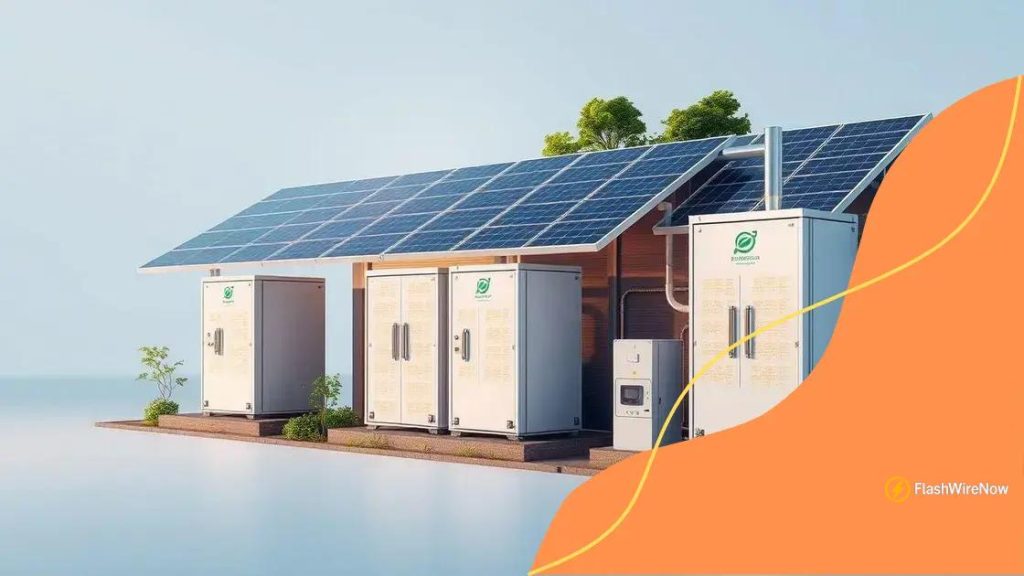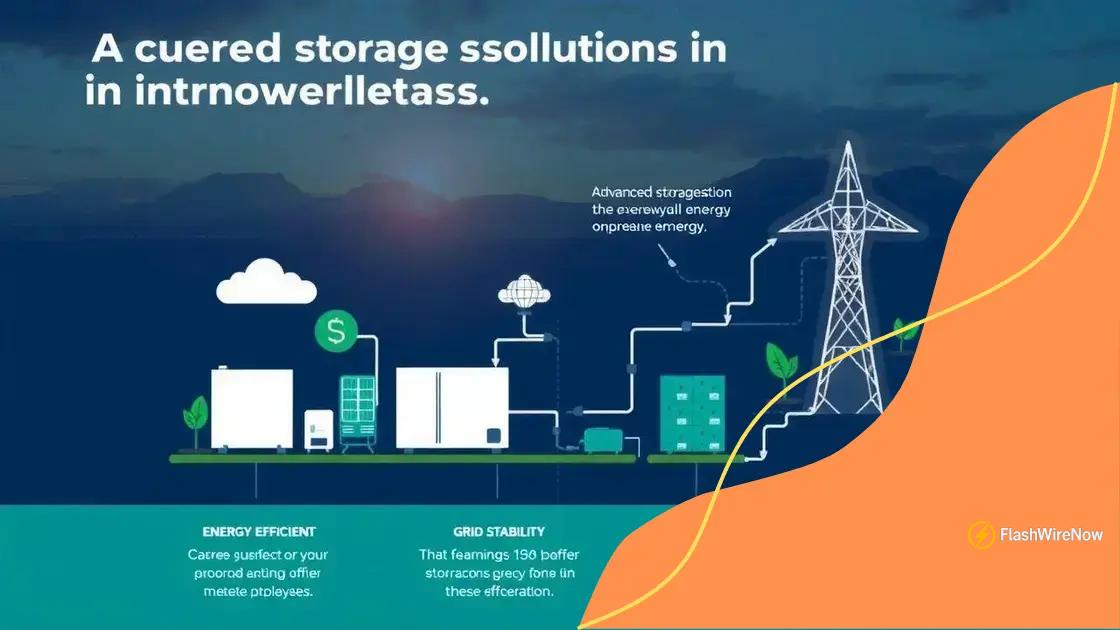Breakthroughs in renewable energy storage: what you need to know

Anúncios
Breakthroughs in renewable energy storage, such as solid-state batteries and advanced thermal systems, enhance efficiency and reliability while supporting the transition to sustainable energy solutions.
Breakthroughs in renewable energy storage are paving the way for a sustainable future. Have you ever wondered how these innovations can change the way we use energy? Let’s dive into this exciting topic.
Anúncios
Understanding renewable energy storage
Understanding renewable energy storage is crucial for harnessing the full potential of clean energy sources. With the increasing demand for sustainable energy solutions, advancements in energy storage technologies play a vital role in ensuring energy availability.
Energy storage allows us to store surplus energy generated from renewable sources like solar and wind. This technology ensures that we can utilize clean energy even when the sun isn’t shining or the wind isn’t blowing. Let’s explore the main types of renewable energy storage.
Types of Renewable Energy Storage
There are several types of renewable energy storage systems that help manage energy efficiently. Each type has its own unique features and benefits:
Anúncios
- Battery Storage: Utilizes batteries to store electricity and release it when needed, improving grid reliability.
- Pumped Hydro Storage: Stores energy by pumping water uphill, then releasing it through turbines to generate electricity.
- Flywheel Storage: Stores energy in rotating masses, providing quick bursts of power.
- Thermal Storage: Stores energy in the form of heat, allowing for power generation or heating when required.
Moreover, the efficiency of these systems is continuously improving. For example, lithium-ion batteries have become a popular choice due to their higher energy density and decreasing costs, making them ideal for various applications, including electric vehicles and grid energy storage.
One of the significant challenges in the renewable energy sector is the intermittency of energy supply. This means that energy production isn’t always steady. For instance, solar panels produce less energy on cloudy days. Therefore, enhancing our understanding of renewable energy storage methods is essential to overcome this challenge. It enables us to maintain a stable energy supply despite fluctuating generation.
To address these challenges, research is actively progressing on developing innovative energy storage solutions. For example, scientists are exploring new materials for batteries that could lead to longer-lasting and more efficient storage systems.
Key breakthroughs in technology
Key breakthroughs in technology have significantly enhanced the realm of renewable energy storage in recent years. These advancements have not only improved efficiency but also made renewable energy more accessible. With a focus on innovation, following trends and new technologies can help us understand how they contribute to a sustainable future.
One major breakthrough is the development of more efficient lithium-ion batteries. These batteries have become the gold standard for energy storage. They enable longer charge retention and faster charging times, making them ideal for homes and electric vehicles alike.
Innovations in Battery Technology
Recent innovations have shifted the perspective on battery technology:
- Solid-state batteries: These batteries use a solid electrolyte instead of liquid, leading to safer and more efficient energy storage.
- Flow batteries: This type allows for larger energy storage, making it suitable for utility-scale applications.
- Recycling programs: New processes are emerging to recycle batteries, reducing environmental impact and costs.
Furthermore, advancements in supercapacitors are also notable. They allow for rapid charging and discharging, which is essential in times of high energy demand. This technology enables a smoother integration of renewable sources into the energy grid.
Moreover, artificial intelligence (AI) is becoming a game-changer in energy storage solutions. AI systems can predict energy usage and optimize storage, thus enhancing grid management. For example, AI can analyze data to determine the best times to store or release energy based on demand and supply fluctuations.
Additionally, researchers are investigating new materials that can improve energy density and reduce costs. These innovations hold the potential to further revolutionize the market and increase the adoption of renewable energy solutions.
Benefits of advanced storage solutions

The benefits of advanced storage solutions in renewable energy are transforming how we harness and use energy. These innovations make it easier to store excess energy and release it when demand is high. This adaptability leads to a more reliable energy supply.
One of the main advantages includes enhanced energy efficiency. With advanced storage solutions, energy generated from sources like solar and wind can be stored and used at optimal times, reducing energy waste. This means that when the sun sets or winds calm, energy is still available for use.
Key Advantages of Advanced Storage Solutions
Here are some key benefits that illustrate why these technologies are crucial:
- Grid Stability: Energy storage helps balance supply and demand, ensuring a stable power grid.
- Integration of Renewables: It facilitates the integration of renewable energy sources into the grid, reducing reliance on fossil fuels.
- Cost Savings: By storing energy, consumers can save on their electricity bills by using stored energy during peak pricing periods.
- Enhanced Reliability: Advanced solutions like batteries protect against outages by providing backup power when needed.
Moreover, advanced storage solutions contribute to reducing greenhouse gas emissions. By improving energy efficiency and increasing the use of renewable energy, these systems support global efforts to combat climate change.
Investing in more efficient storage technology also leads to economic benefits. This sector creates jobs in manufacturing, installation, and maintenance, promoting a green economy. As the demand for clean energy grows, so does the need for skilled workers in advanced storage solutions.
Another important point is that these storage technologies can improve energy access in remote areas where traditional power grids are unavailable. Off-grid storage systems allow communities to harness local renewable energy sources, providing them with reliable electricity.
Challenges in implementing new storage methods
Implementing new storage methods in renewable energy comes with several challenges that need careful consideration. As technology advances, it is essential to understand these obstacles to maximize the benefits of energy storage solutions.
One major challenge lies in the cost of technology. Although advancements are being made, many new storage systems require significant upfront investments. These costs can discourage widespread adoption, particularly for smaller businesses and communities.
Key Challenges Faced
Various challenges impact the implementation of advanced storage methods:
- Infrastructure Needs: Upgrading existing energy infrastructure to accommodate new storage systems can be costly and time-consuming.
- Regulatory Barriers: Regulations may not keep pace with technological advancements, hindering innovation and deployment.
- Supply Chain Issues: Sourcing materials for storage technologies can be challenging as demand increases, impacting production timelines.
- Technical Limitations: Current technologies may have limitations in capacity or efficiency, restricting their effectiveness for larger applications.
Additionally, there can be a lack of education and awareness about new storage methods among consumers and businesses. This knowledge gap can prevent potential users from understanding how these technologies work and their benefits.
Another significant concern is the environmental impact of some new materials used in energy storage. While the goal is sustainability, producing some technologies can have a negative ecological footprint, which raises questions about their overall efficacy.
Moreover, as more renewables are integrated, the reliability of new storage solutions needs to be proven in real-world scenarios. Stakeholders want assurance that these systems can deliver consistent performance during peak demand or emergency situations.
Future trends in renewable energy storage
Future trends in renewable energy storage are set to reshape how we think about energy management. As technology continues to evolve, new methods and systems promise to enhance efficiency and sustainability.
One of the primary trends is the ongoing development of solid-state batteries. These batteries offer increased energy density and improved safety compared to traditional lithium-ion batteries. As manufacturers refine these technologies, we can expect to see them become more widespread in electric vehicles and home energy systems.
Emerging Technologies
Several emerging technologies are gaining attention in the storage landscape:
- Hybrid systems: Combining different types of storage such as batteries and supercapacitors enhances flexibility and efficiency.
- Bio-inspired materials: Researchers are exploring materials inspired by nature to make batteries more efficient and environmentally friendly.
- Advanced thermal storage: This method captures and retains heat energy for later use, providing an efficient way to store energy from solar sources.
- AI and machine learning: These technologies are increasingly used to optimize energy storage systems by predicting energy demand and improving management.
Another growing trend is the concept of decentralization in energy storage. Instead of relying solely on large power plants, individuals and communities are adopting decentralized systems. This trend allows for localized energy generation and storage, giving users greater control over their energy consumption.
The integration of renewable energy with the grid will also evolve. With the advancement of smart grid technologies, energy storage systems will become more integrated, allowing homes and businesses to manage their energy use effectively. Smart grids can automatically adjust to changes in energy supply and demand, facilitating the use of stored renewable energy at the right times.
Finally, policies and incentives geared towards renewable energy storage will shape its future. Governments are beginning to implement measures that encourage investment in advanced storage solutions, providing financial incentives for both consumers and businesses. These initiatives can accelerate the transition to a more sustainable energy future.
FAQ – Frequently Asked Questions About Renewable Energy Storage
What are the main benefits of advanced energy storage solutions?
Advanced energy storage solutions improve energy efficiency, enhance grid stability, and contribute to sustainability by optimizing the use of renewable energy.
How do emerging technologies impact renewable energy storage?
Emerging technologies like solid-state batteries and smart grids significantly improve energy storage performance, safety, and integration with renewable sources.
What challenges do we face when implementing new storage methods?
Challenges include high costs, regulatory barriers, and the need for infrastructure upgrades, which can hinder the adoption of innovative storage technologies.
What trends can we expect in the future of energy storage?
Future trends include the rise of decentralized energy systems, advancements in battery technology, and policies encouraging the use of renewable energy storage.





